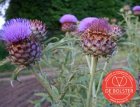Cardoon BIO De Bolster (1380)
Cardoon looks a lot like artichoke, the plants are closely related. In contrast to artichoke, cardoons are grown mainly for the edible leaf (if bleached - see below), and less so for the flowers. Cardoons often become a sturdy plant, up to one and a half metres high, with deeply incised leaves, grey-green in colour. The plant also produces artichoke-like flowers. The decorative properties of the plant make it very popular with vegetable gardeners.
Cardoon is therefore a warmth-loving plant - the plant originates from the Mediterranean. Preferably give cardoons a sheltered spot in your vegetable garden. The plant produces a lot of leaves in a short period of time and therefore needs fertile, moist soil. Before planting, give it some extra compost or well digested manure. Also loosen the soil well before planting. During the growing period you could add some fertiliser if necessary.
In warmer areas cardoons can easily hibernate, in the Dutch climate the plant can freeze to death. Covering the plant/root during severe frost gives the plant a higher chance of survival.
The leaf stalks of cardoons are edible after cooking. These stems are usually bleached to reduce the fibrousness.
Sow cardoons in May in the garden. Sow a number of seeds per spot, leave the strongest plant and remove the rest. Pre-sow in pots, and then transplant as well. Start bleaching the plant at the end of August: make sure the leaves are dry when you bind them together, otherwise the leaves will blemish easily. Wind the leaves with a piece of string, and prevent light from reaching the leaves. Originally they always used jute for this, another air permeable material that blocks light can also be used.
Cultivation under glass:
Sowing: April
harvesting: August - September
full ground:
sowing: May
harvesting: September - October
Other specifications
Contents small package: 2 grams (for min. 10 m2)
Number of seeds per gram : 25 seeds
Plant spacing : 80x60 cm
Plant height : 80-150 cm
Pitch : sun
Cardoon is therefore a warmth-loving plant - the plant originates from the Mediterranean. Preferably give cardoons a sheltered spot in your vegetable garden. The plant produces a lot of leaves in a short period of time and therefore needs fertile, moist soil. Before planting, give it some extra compost or well digested manure. Also loosen the soil well before planting. During the growing period you could add some fertiliser if necessary.
In warmer areas cardoons can easily hibernate, in the Dutch climate the plant can freeze to death. Covering the plant/root during severe frost gives the plant a higher chance of survival.
The leaf stalks of cardoons are edible after cooking. These stems are usually bleached to reduce the fibrousness.
Sow cardoons in May in the garden. Sow a number of seeds per spot, leave the strongest plant and remove the rest. Pre-sow in pots, and then transplant as well. Start bleaching the plant at the end of August: make sure the leaves are dry when you bind them together, otherwise the leaves will blemish easily. Wind the leaves with a piece of string, and prevent light from reaching the leaves. Originally they always used jute for this, another air permeable material that blocks light can also be used.
Cultivation under glass:
Sowing: April
harvesting: August - September
full ground:
sowing: May
harvesting: September - October
Other specifications
Contents small package: 2 grams (for min. 10 m2)
Number of seeds per gram : 25 seeds
Plant spacing : 80x60 cm
Plant height : 80-150 cm
Pitch : sun
€ 2.69 € 2.55

